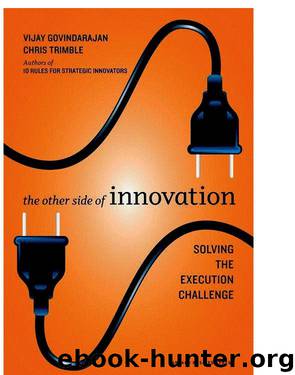The Other Side of Innovation: Solving the Execution Challenge by Govindarajan Vijay; Trimble Chris

Author:Govindarajan, Vijay; Trimble, Chris
Language: eng
Format: epub
A Process for Learning from Experiments
The basic steps for learning from experiments are straightforward:
Before launching an experiment, write down what you plan to do, what you expect to
happen, and why. Draw lessons learned by analyzing differences between what you
thought would happen and what actual y happened. Then, based on lessons learned,
revise the plan. (See figure 4-2.)
That is the whole bal game! If you can execute this process rigorously and
dispassionately, your chances of drawing the right lessons learned from a business
experiment go up dramatical y. The crucial learning step is the analysis of the disparities
between predictions and outcomes. Through this analysis, assumptions are either
validated or invalidated. Lessons are learned. Predictions improve.
This process has a formal name—the scientific method. For many, the phrase
scientific method surfaces bad memories from youth. Perhaps the last time you thought
about the scientific method you were studying high school chemistry, and maybe you
didn’t even like chemistry that much. Nonetheless, the scientific method is the
innovator’s indispensable friend. The process of learning through experimentation is the
scientific method.
When running innovation initiatives, businesspeople need to behave more like
scientists. We believe that disciplined experimentation should take its place in the
business school curriculum right alongside marketing and finance.
FIGURE 4-2
Formalizing an experiment
Each Project Needs Its Own Plan
With a basic process that is so easy to describe, what could possibly go wrong? Oh, if
only the list were short. The learning process can break down in any number of ways.
Most of these breakdowns originate in an uncomfortable juxtaposition. For a
scientist, formal experimentation is routine. For a businessperson, however, ongoing
operations are routine and experiments are the exception. Many common disruptions in
the learning process arise from awkward col isions between what’s good for ongoing
operations and what’s good for experiments.
We’ve just given a basic description of a formal learning process. But business
organizations already have such a process. It is, of course, the planning process. The
basics are the same. As a part of routine planning, managers make predictions and
later analyze the differences between predictions and outcomes.
Unfortunately, these high-level similarities mask fundamental differences. For
example, plans for innovation initiatives have a much different purpose than plans for
ongoing operations. A Performance Engine leader’s central focus is to execute the plan.
In an innovation initiative, however, the plan is a hypothesis. Your central focus should be
testing and improving the hypothesis as quickly and efficiently as possible. Doing so
leads to the best possible results. If your initiative is an entirely new business, your
hypothesis is your strategy. Your job is not to execute the strategy, as it is in the
Performance Engine, but to test and improve it.
This distinct purpose requires distinct thinking when analyzing results. The most
fundamental premise underlying analysis in the Performance Engine is that a business is
an ongoing concern; in other words, that past is precedent. This premise—that past is
precedent—is the underpinning for accounting rules. Given that innovation is inherently
new and uncertain—that there is no precedent — this recognition should make you
squirm.
As a result, each innovation initiative must have its own, dedicated, separate, stand-
alone plan. The stand-alone plan creates much-needed space for distinct thinking. It also
prevents lessons learned from being obscured.
Download
This site does not store any files on its server. We only index and link to content provided by other sites. Please contact the content providers to delete copyright contents if any and email us, we'll remove relevant links or contents immediately.
Nudge - Improving Decisions about Health, Wealth, and Happiness by Thaler Sunstein(7657)
Deep Work by Cal Newport(6966)
Principles: Life and Work by Ray Dalio(6296)
The Doodle Revolution by Sunni Brown(4713)
Factfulness: Ten Reasons We're Wrong About the World – and Why Things Are Better Than You Think by Hans Rosling(4713)
Eat That Frog! by Brian Tracy(4483)
Thinking in Bets by Annie Duke(4185)
Hyperfocus by Chris Bailey(4086)
Visual Intelligence by Amy E. Herman(3753)
Writing Your Dissertation in Fifteen Minutes a Day by Joan Bolker(3696)
Ogilvy on Advertising by David Ogilvy(3554)
Hidden Persuasion: 33 psychological influence techniques in advertising by Marc Andrews & Matthijs van Leeuwen & Rick van Baaren(3519)
How to Win Friends and Influence People in the Digital Age by Dale Carnegie & Associates(3518)
How to win friends and influence people by Dale Carnegie(3437)
The Pixar Touch by David A. Price(3389)
Schaum's Quick Guide to Writing Great Short Stories by Margaret Lucke(3346)
Deep Work: Rules for Focused Success in a Distracted World by Cal Newport(3182)
Work Clean by Dan Charnas(3080)
The Slow Fix: Solve Problems, Work Smarter, and Live Better In a World Addicted to Speed by Carl Honore(2975)
